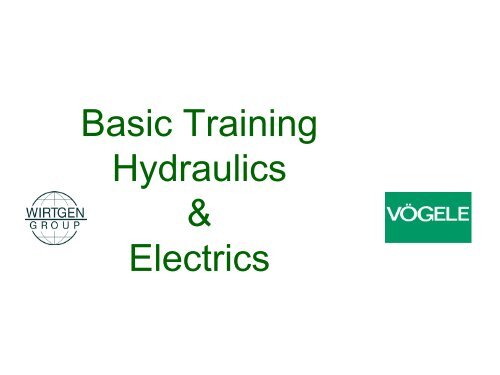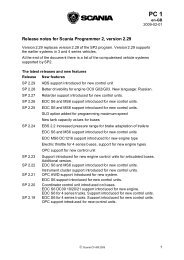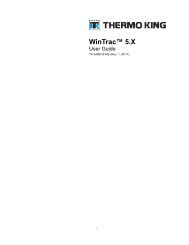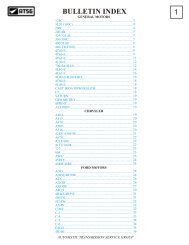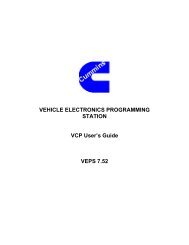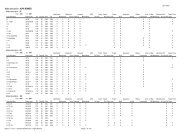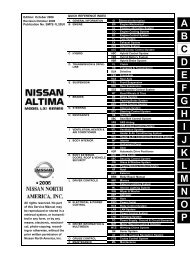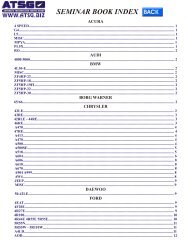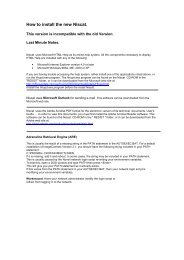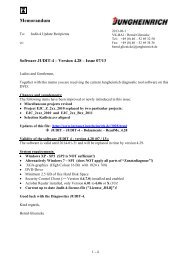Vogele Basic Training Hydraulics & Electrics
Vogele Basic Training Hydraulics & Electrics
Vogele Basic Training Hydraulics & Electrics
You also want an ePaper? Increase the reach of your titles
YUMPU automatically turns print PDFs into web optimized ePapers that Google loves.
<strong>Basic</strong> <strong>Training</strong><br />
<strong>Hydraulics</strong><br />
&<br />
<strong>Electrics</strong>
<strong>Training</strong> schedule<br />
Day 1: <strong>Hydraulics</strong> ( 08:00 – 16:00 Hrs )<br />
Day 2: <strong>Electrics</strong> ( 08:00 – 16:00 Hrs )
Table of Contents - <strong>Hydraulics</strong><br />
H.1.0 The history of hydraulics<br />
H.2.0 Aspects of hydraulics<br />
H.3.0 Units of measurement in hydraulics<br />
H.4.0 Legend of abbreviations<br />
H.4.1 Lines<br />
H.4.2 Valves<br />
H.4.3 Components<br />
H.5.0 Circuit symbols and circuits<br />
H.5.1 Explanation<br />
H.5.2 Circuit symbols – Parts 1 - 3<br />
H.5.3 Directional control valves – Parts 1 – 2<br />
H.5.3.1 Switching positions<br />
H.5.3.2 Types of operation<br />
H.5.4 Flow control valves<br />
H.5.5 Shut-off valves<br />
H.5.6 Pressure control valve<br />
H.5.6.1 Explanation and zero position<br />
H.5.6.2 Adjustability<br />
H.5.6.3 Activation<br />
H.5.7 Pressure reducing valve<br />
H.6.0 Circuit diagrams<br />
H.6.1 Types of circuit diagram<br />
H.6.2 Hydraulic function diagram (HFP) –<br />
Parts 1 – 4<br />
H.6.3 Hydraulic piping diagram (HVP)<br />
H.6.4 Symbols and abbreviations for HVPs<br />
H.7.0 Open circuit<br />
H.7.1 Overload protection<br />
H.7.2 Directional control valve<br />
H.7.3 Reverse direction of rotation<br />
H.7.4 Flow control valve<br />
H.7.5 Variable displacement pump<br />
H.7.6 Free-wheel drive mechanism<br />
H.7.7 Accessories<br />
H.8.0 Closed circuit<br />
H.8.1 <strong>Basic</strong> layout<br />
H.8.2 Changing direction of rotation<br />
H.8.3 Overload protection<br />
H.8.4 Leakage<br />
H.8.5 Feed<br />
H.8.6 Accessories<br />
H.9.0 Hydraulic pumps<br />
H.9.1 Designs<br />
H.9.2 Fixed displacement pump – Parts 1 – 2<br />
H.9.3 Axial piston variable displacement pump<br />
(bidirectional)<br />
H.9.3.1 Conveyor– Auger specimen circuit diagram<br />
H.9.3.2 Circuit diagram<br />
H.9.3.3 Traction drive<br />
H.9.3.4 Traction drive specimen circuit diagram<br />
H.10.0 Hydraulic motors<br />
H.10.1 Designs<br />
H.10.2 Categorisation of hydraulic motors<br />
H.10.3 Axial piston variable displacement motor<br />
H.11.0 Viscosity classes<br />
H.12.0 Oils used at VÖGELE<br />
H.13.0 Annex<br />
H.13.1 Principles of hydraulics<br />
H.13.2 Advantages of hydraulics<br />
H.13.3 Disadvantages of hydraulics<br />
H.13.4 Applications<br />
H.13.5 Hydraulic fluids
E.1.0 Hazards<br />
Table of Contents - <strong>Electrics</strong><br />
E.6.0 Circuit symbols<br />
E.2.0 Units of measurement in electrics<br />
E. 2.1 Electric current / Electric intensity<br />
E. 2.2 Types of electricity<br />
E. 2.3 Measuring electric current<br />
E. 2.4 Electricity measurement circuit diagram<br />
E. 2.5 Electrical voltage<br />
E. 2.6 Measuring electrical voltage<br />
E. 2.7 Electrical resistance<br />
E. 2.8 Measuring resistance<br />
E. 2.9.1 Electrical power<br />
E. 2.9.2 Calculating electrical power<br />
E. 3.0 Relationships between units of electricity<br />
E. 3.1 Ohm’s Law<br />
E. 3.2 The magic triangle<br />
E.4.0 Connecting resistors<br />
E.4.1.1 – 4.1.2 Series connection<br />
E.4.2.1 – 4.2.2 Parallel connection<br />
E. 5.0 Legend of abbreviations<br />
E.6.1 Switch and button symbols<br />
E.6.2 Symbols – Part 1<br />
E.6.3 Symbols – Part 2<br />
E.6.4 Symbols – Part 3<br />
E. 7.0 Relays<br />
E. 7.1 Design and function<br />
E. 7.2 Relays used at VÖGELE<br />
E. 8.0 Diodes<br />
E. 8.1 Design and function<br />
E. 8.2 Conducting direction and reverse direction<br />
E. 8.3 Testing a diode<br />
E. 9.0 Fuses<br />
E. 10.0 Reading a circuit diagram<br />
E. 10.1 Circuit diagram<br />
E. 10.2 Bottom bar and information<br />
E. 11.0 Mains systems<br />
E. 11.1 Mains 230 V / 400 V AC<br />
E. 11.2 Mains 24 V DC<br />
E. 12.0 Measuring instruments<br />
E.12.1 Multimeters – Parts 1 and 2<br />
E.12.2 Clamp-on amperemeters – Parts 1<br />
and 2
<strong>Basic</strong> Principles<br />
<strong>Hydraulics</strong>
H.1.0 The history of hydraulics:<br />
<strong>Hydraulics</strong> ( from the Greek hydro = water and aulos = pipe or flute ) is the science of the flow behaviour of fluids.<br />
In particular, it involves the flow processes in open channels ( canals, rivers ) and lakes, as well as pipelines, pumps and ground water.<br />
In the field of mechanical engineering, the technical components of drives and drivelines that function with fluids are referred to as hydraulic.<br />
Joseph Bramah, England, is regarded as the founder of technical hydraulics. In 1795, he developed a hydromechanical machine operated with<br />
pressurized water that functioned according to the hydrostatic law of Blaise Pascal. In 1851, Sir W. Armstrong developed the weight accumulator,<br />
a reservoir that allowed the generation of large volume flows. In 1882, the London Hydraulic Power Company put a central pressurized water<br />
supply for multiple hydraulic systems into operation. The first power steering system was developed by Harry Vickers around 1925.<br />
H.2.0 <strong>Hydraulics</strong> deals primarily with the following aspects:<br />
- Properties of fluids:<br />
- Density<br />
- Viscosity<br />
- Elasticity<br />
- Specific heat capacity<br />
- Surface tension (capillary action )<br />
- Solubility of gases, air content of water<br />
- Hydrostatics:<br />
-Pressure<br />
- Uplift<br />
- Theoretical description of the flow processes<br />
- Kinematics and dynamics<br />
- Continuity condition, mass behaviour<br />
- Principle of linear momentum<br />
- Equation of motion (Euler‘s equation of motion)<br />
- Bernoulli‘s equation of energy (simple formulas for calculating outflow)<br />
- Hagen-Poiseuille law<br />
- Laminar flow<br />
- Turbulent flow<br />
- Real flows<br />
- Flows in pipelines<br />
- Flows in open channels, such as rivers, lakes, canals<br />
- Flows in ground water
H.3.0 Units of measurement in hydraulics<br />
The SI unit of pressure is the Pascal with the standard symbol Pa. One Pascal corresponds<br />
to a pressure of one Newton (N) per square meter (m²):<br />
1 Pa = 1 N/m2 = 1 kg/m s²<br />
The unit of pressure most predominantly used for hydraulics is the Bar.<br />
One Bar corresponds to 100,000 Pa, 1,000 hPa or 100 kPa.<br />
In engineering, the unit N/mm² is used both for pressures and for mechanical tension.<br />
In this context, 1 N/mm² = 1MPa<br />
Other units of pressure that can be found but which are no longer permissible are:<br />
-1 Torr = approx. 133.3 Pa<br />
-1 meter water column (mWc) = 9.80665 kPa<br />
-1 technical atmosphere (at) = 98066.5 Pa<br />
-1 physical atmosphere (atm) = 101.325 kPa<br />
-1 psi = 6894.757293168 Pa
H.4.0 Legend of abbreviations<br />
H.4.1 Lines<br />
P = Pressure line ( from the English Power )<br />
H.4.3 Other components<br />
Q = Pump ( standardized symbol )<br />
R = Return line<br />
S = Suction line<br />
M<br />
F<br />
= Motor<br />
= Filter<br />
T = Tank line<br />
MT = Flow divider (Mengenteiler)<br />
L = Leakage oil line<br />
Z<br />
= Cylinder (Zylinder)<br />
H.4.2 Valves<br />
DBV = Pressure control valve (Druckbegrenzungsventil)<br />
DRV = Pressure reducing valve (Druckreduzierventil)<br />
RSV = Non return valve (Rückschlagventil)<br />
SRV = Flow control valve (Stromregelventil)<br />
ST = Control block (Steuerblock)<br />
SA = Collector (Sammler)<br />
DS = Pressure switch (Druckschalter)<br />
PVG = Transfer gearbox (Pumpenverteilergetriebe)<br />
HÖK = Hydraulic oil cooler (Hydraulikölkühler)<br />
PM = Proportional magnet<br />
WV = Directional control valve (Wegeventil)
H.5.0 Circuit symbols and circuits<br />
H.5.1 Explanation<br />
A circuit diagram is the plan of a hydraulic system. The components are presented by means of<br />
standardized symbols.<br />
These diagrams are part of the requisite documentation of every system and are particularly<br />
important for the creation and maintenance of a system.<br />
The list of circuit symbols contains a comprehensive array of symbols used in hydraulics.<br />
Circuit diagrams may be drawn up individually, in line with company specifications or in accordance<br />
with standards (DIN ISO 1219).<br />
They can represent components, such as operating and control circuits, the steps of the operating<br />
sequence, the circuit components with their designations and the associated lines and connections.<br />
The spatial arrangement of the components is not usually taken into consideration, or it is presented<br />
in a separate overview plan.<br />
A symbol exclusively depicts the function of a component / device. It says nothing about the<br />
construction or point of installation of the hydraulic components.<br />
Symbols are presented in one colour, normally idle, without current and in their initial position.
H.5.0 Circuit symbols and circuits<br />
H.5.2 Circuit symbols – Part 1<br />
Pressure connection<br />
with access line<br />
Vent line<br />
Control line<br />
Leakage oil line<br />
Flexible line<br />
Mechanical connection<br />
(shaft, level, bar)<br />
Spring<br />
Throttle<br />
Line connection<br />
Orifice<br />
Line junction<br />
Flow direction<br />
Bleed point<br />
Rotatability<br />
Pressure connection<br />
with plugs<br />
Adjustability
H.5.0 Circuit symbols and circuits<br />
H.5.2 Circuit symbols – Part 2<br />
Border of assemblies /<br />
blocks<br />
Single-acting cylinder<br />
Manometer<br />
Double-acting cylinder<br />
Pressure source<br />
Electric motor<br />
M<br />
Differential cylinder<br />
(double-acting)<br />
Combustion engine<br />
Cylinder with damping<br />
(double-acting)<br />
Coupling
H.5.0 Circuit symbols and circuits<br />
H.5.2 Circuit symbols – Part 3<br />
Pressure switch<br />
Hydraulic<br />
reservoir<br />
Filter<br />
Cooler
H.5.0 Circuit symbols and circuits<br />
H.5.3 Directional control valves – Part 1<br />
4/2<br />
4/3<br />
Directional control valves are designated according to the number of connections<br />
and switching positions. The number of connections comes first, followed by the<br />
number of switching positions.
H.5.0 Circuit symbols and circuits<br />
H.5.3 Directional control valves – Part 2<br />
2 0 1 2 0 1<br />
Directional control valves are represented by individual<br />
rectangles.<br />
The number of fields equates to the number of switching<br />
positions, which are designated with the figures ( 0 / 1 / 2 ).<br />
A B<br />
2 0 1<br />
The position of the respective lines indicates how the<br />
connections are connected.<br />
Small dashes on the connections indicate shut-offs.<br />
A B<br />
2 0 1<br />
P R<br />
Connections are designated with capital letters.<br />
A,B,C = Vent lines<br />
R,S = Vent (runback)<br />
P = Feeder (pressure line) X,Y,Z = Control line<br />
P R<br />
If a valve is switched proportionally, this is indicated by lines<br />
above and below the switching positions.
H.5.0 Circuit symbols and circuits<br />
H.5.3.1 Switching positions:<br />
Circulating position<br />
Forward flow<br />
position<br />
Floating position<br />
Reverse flow<br />
position<br />
Shut-off position
H.5.3 Circuit symbols and circuits<br />
H.5.3.2. Types of operation<br />
Spring<br />
Mechanical<br />
Magnetic<br />
Hand lever<br />
Hydraulic<br />
Locking
H.5.0 Circuit symbols and circuits<br />
H.5.4 Flow control valves (SRV):<br />
Flow control<br />
valve with orifice<br />
Flow control valve (SRV), fixed<br />
(for one flow direction only)<br />
Flow control valve<br />
(SRV), adjustable<br />
(for one flow<br />
direction only)<br />
Flow control valve (SRV),<br />
adjustable<br />
(for one flow direction only)<br />
With non-return valve (RSV)<br />
3-way flow control valve
H.5.0 Circuit symbols and circuits<br />
H.5.5 Shut-off valves<br />
Flow divider (MT)<br />
Non-return valve (RSV),<br />
without closing spring<br />
Non-return valve (RSV),<br />
with closing spring
H.5.0 Circuit symbols and circuits<br />
H.5.6 Pressure control valve (DBV):<br />
H.5.6.1 Explanation and zero position<br />
If the pressure in a hydraulic system rises to a level that is undesirable and which the system cannot<br />
tolerate, the weakest point of the system will be destroyed. Pressure control valves - in short DBV –<br />
feed the oil not accepted by the consumer at the highest permissible pressure back to the tank.<br />
A<br />
A<br />
B<br />
B<br />
Closed zero position<br />
Open zero position
H.5.0 Circuit symbols and circuits<br />
H.5.6 Pressure control valve (DBV):<br />
H.5.6.2 Adjustability<br />
A<br />
A<br />
B<br />
B<br />
Pressure control valve DBV,<br />
fixed position<br />
Pressure control valve DBV,<br />
adjustable
H.5.0 Circuit symbols and circuits<br />
H.5.6 Pressure control valve (DBV):<br />
H.5.6.3 Activation<br />
A<br />
A<br />
C<br />
C<br />
B<br />
Pressure control valve DBV with<br />
additional remote activation connection<br />
and external control outlet.<br />
L<br />
B<br />
Pressure control valve DBV with<br />
additional remote activation connection<br />
and internal control outlet.
H.5.0 Circuit symbols and circuits<br />
H.5.7 Pressure reducing valve (DRV):<br />
P<br />
T<br />
A
H.6.0 Circuit diagrams<br />
H.6.1 Types of circuit diagram<br />
At VÖGELE, we distinguish between two types of circuit diagram.<br />
On the one hand, we have the „Hydraulic Function Diagram“ ( “Hydraulischer<br />
Funktionsplan” HFP ).<br />
And on the other hand, we have the „Hydraulic Piping Diagram“ ( “Hydraulischer<br />
Verschlauchungsplan” HVP ).<br />
As the name already implies, the HFP illustrates the hydraulic functions, while the HVP,<br />
in contrast, illustrates individual components, such as pumps, hoses or consumers<br />
(motors or cylinders) and how they are interconnected.<br />
The parts numbers of the individual components are always entered in both diagrams.
H.6.0 Circuit diagrams H.6.2 Layout of a hydraulic function diagram (HFP) - Part 1<br />
Every page of a function plan is<br />
broken down into sections numbered<br />
from 1 to 8.<br />
This makes it easier to trace the path<br />
of an individual function.<br />
P8/10.<br />
3<br />
Cross-references are provided in order to be<br />
able to trace the course of a flow (oil flow) in<br />
the circuit diagram. This information contains<br />
the name of the oil line ( e.g. P8) and the page<br />
number with section - after the slash (e.g.<br />
/10.3) – to which the oil line leads.
H.6.0 Circuit diagrams<br />
H.6.2 Layout of a hydraulic function diagram (HFP) - Part 2<br />
The date of creation must always be<br />
entered here<br />
Order number and primary function<br />
Function designations are always<br />
listed below the respective function,<br />
sometimes with the part number<br />
Machine type and validity<br />
Serial number from/to<br />
Page number and total number of pages<br />
Q9/Q10<br />
96.2794.1000<br />
Levelling system<br />
left<br />
Levelling system<br />
right<br />
Brake<br />
Interlock<br />
Screed
H.6.0 Circuit diagrams H.6.2 Layout of a hydraulic function diagram (HFP) - Part 3<br />
A dot-and-dashed line<br />
always indicates a<br />
complete component.<br />
A component is always<br />
labelled with its<br />
customary abbreviation.
H.6.0 Circuit diagrams H.6.2 Layout of a hydraulic function diagram (HFP) - Part 4<br />
The positions of the valves in the circuit diagram correspond precisely to the positions on the machine<br />
11<br />
11<br />
1
H.6.0 Circuit diagrams H.6.3 Hydraulic piping diagram (HVP)<br />
Motor (M)<br />
with part number<br />
Pump (Q) with<br />
part number<br />
GEV = Straight screwed coupling<br />
M 14 x 1.5 = Thread x flank lead<br />
8L = 8 stands for nominal width,<br />
L stands for lightweight<br />
Hose with 90° elbow connection<br />
and part number
H.6.0 Circuit diagrams<br />
H.6.4 Symbols and abbreviations for HVPs - Part 1<br />
Welded fitting (ASV)<br />
Welded bulkhead fitting (ESV)<br />
Inlay baffle (BL)<br />
Adjustable – T – fitting (ETV)<br />
Spacer adapter (DA)<br />
Adjustable elbow fitting (EWV)<br />
Restrictor fitting (DV)<br />
Flat nut (FLM)<br />
Straight screw-in fitting with<br />
sealing cap (EGE)<br />
Straight screw-on fitting (GAI)<br />
Adjustable – L – fitting (ELV)<br />
Straight screw-in fitting (GEV)
H.6.0 Circuit diagrams<br />
H.6.4 Symbols and abbreviations for HVPs - Part 2<br />
Straight flanged fitting<br />
L - Series (GFL)<br />
Hollow bolt (HS)<br />
Straight flanged fitting<br />
S – Series (GFS)<br />
Tapered reducer fitting (KOR)<br />
Straight reducing fitting (GRV)<br />
Cross fitting (KV)<br />
Straight bulkhead fitting (GSV)<br />
Manometer screw-on fitting (MAV)<br />
Straight fitting (GV)<br />
Manometer fitting (MAVE)<br />
Straight intermediate fitting (GZV)<br />
Screw-on measurement connection<br />
(Minim. DKO)
H.6.0 Circuit diagrams<br />
H.6.4 Symbols and abbreviations for HVPs - Part 3<br />
Screw-in measurement<br />
connection (Minim. GEV)<br />
Screw-in reducer fitting (RI)<br />
Straight measurement<br />
connection (Minim. GV)<br />
Ring eye (RIG)<br />
Reducer fitting (REDV)<br />
Pipe connection fitting ROV)<br />
Non-return valve (RHD)<br />
Olive (SR)<br />
Non-return valve (RHV)<br />
Swivel fitting (SWV)<br />
Non-return valve (RHZ)<br />
T – fitting (TV)
H.6.0 Circuit diagrams<br />
H.6.4 Symbols and abbreviations for HVPs - Part 4<br />
Sleeve nut (ÜM)<br />
Elbow flanged fitting<br />
S – Series (WFS)<br />
Blanking plug, including<br />
sleeve nut (VKA)<br />
Elbow bulkhead fitting (WSV)<br />
Blanking plug (VS)<br />
Elbow fitting (DCV)<br />
Blanking bolt (VSS)<br />
(sealing edge)<br />
Blanking bolt (VSTI)<br />
(Eolastic – seal)<br />
Elbow flanged fitting<br />
L – Series (WFL)
H.7.0 Open circuit<br />
The hydraulic pump sucks hydraulic fluid (hydraulic oil) out of an unpressurized container (hydraulic tank)<br />
and feeds the hydraulic fluid into a hydraulic system. The pressurized hydraulic fluid can then be fed via<br />
lines, hoses and valves to „actuators“ ( hydraulic cylinders, hydraulic motors) where the actual work is<br />
carried out.<br />
Axial piston machines are self-priming and are therefore pressurized on the suction-side in certain<br />
individual cases (
H.7.0 Open circuit<br />
H.7.1 Overload protection<br />
Volume flow constant<br />
PCV<br />
Fixed<br />
displacement<br />
pump<br />
Motor<br />
Suction line<br />
Runback<br />
Tank<br />
The pressure control valve (PCV)<br />
protects the system against overloading.
H.7.0 Open circuit<br />
H.7.2 Directional control valve<br />
Volume flow constant<br />
DCV<br />
PCV<br />
Fixed<br />
displacement<br />
pump<br />
Motor<br />
Suction line<br />
Tank<br />
A directional control valve (DCV) can also be installed<br />
in order to change the direction of rotation of the motor.
H.7.0 Open circuit<br />
H.7.3 Reverse direction of rotation<br />
Volume flow constant<br />
DCV<br />
PCV<br />
Fixed<br />
displacement<br />
pump<br />
Motor<br />
Suction line<br />
Tank<br />
The directional control valve makes it possible to reverse<br />
the direction of rotation or travel at the consumer.
H.7.0 Open circuit<br />
H.7.4 Flow control valve<br />
FCV<br />
PCV<br />
Fixed<br />
displacement<br />
pump<br />
Motor<br />
Suction line<br />
Tank<br />
The use of a flow control valve (FCV)<br />
renders the motor speed variable.
H.7.0 Open circuit<br />
H.7.6 Variable displacement pump<br />
Volume flow variable<br />
PCV<br />
Variable<br />
displacement<br />
pump<br />
Motor<br />
Tank<br />
A variable displacement pump replaces<br />
a fixed displacement pump and flow control valve.
H.7.0 Open circuit<br />
H.7.6 Free-wheel drive mechanism<br />
Volume flow variable<br />
PCV<br />
Variable<br />
displacement<br />
pump<br />
Motor<br />
Tank<br />
The use of additional directional control valve functions<br />
result in a free-wheel drive mechanism of the consumer.
H.7.0 Open circuit<br />
H.7.7 Accessories<br />
Volume flow variable<br />
Variable<br />
displacement<br />
pump<br />
Filter<br />
PCV<br />
Motor<br />
HOC<br />
Tank<br />
The circuit can be supplemented through accessories,<br />
such as filters and coolers, etc.
H.8.0 Closed circuit<br />
The hydraulic pump is fed with hydraulic fluid returning directly from the actuator (hydraulic motor).<br />
The hydraulic fluid is under low pressure of roughly 10 to 30 bar and is raised to a higher pressure level<br />
(high pressure) by the hydraulic pump before being fed back to the actuator again.<br />
The advantages of this process are high speeds and filtering at a low pressure of just 10 to 20% of the volume<br />
of the primary pump.<br />
The circuit has high pressure and low pressure sides, which change with the direction of load.<br />
The high pressure side is protected by pressure control valves, which relieve the pressure towards the<br />
low pressure side.<br />
The medium remains in the circuit.<br />
Only the leakage at the hydraulic pump and hydraulic motor (depending on operating data) has to be replaced.<br />
This is realized by a (usually) directly flange-connected auxiliary pump that permanently feeds a sufficient fluid<br />
volume ( feed volume ) from a tank to the low pressure side via a non-return valve.<br />
The unneeded volume flow of the feed pump working in the open circuit is returned to the tank via a feed<br />
pressure control valve.<br />
Volume flow variable<br />
Pump,<br />
variable<br />
Motor,<br />
variable
H.8.0 Closed circuit<br />
H.8.1 <strong>Basic</strong> layout<br />
Volume flow variable<br />
Pump,<br />
variable<br />
Motor<br />
<strong>Basic</strong> layout with variable displacement pump<br />
and variable displacement motor.
H.8.0 Closed circuit<br />
H.8.2 Changing direction of rotation<br />
Volume flow variable<br />
Pump,<br />
variable<br />
Motor<br />
The drive direction of rotation of the pump is unidirectional, while that<br />
of the motor is bidirectional. The pivoting angle of the pump is infinitely<br />
adjustable via the zero position, i.e. the volume flow direction can be<br />
reversed.<br />
The motor pivots unidirectionally and is likewise infinitely adjustable.
H.8.0 Closed circuit<br />
H.8.3 Overload protection<br />
Volume flow variable<br />
Pump,<br />
variable<br />
PCVs<br />
Motor<br />
The maximum permissible pressure is ensured by means<br />
of pressure control valves (PCV). A pressure control valve (PCV)<br />
is used for each pressure side.
H.8.0 Closed circuit<br />
H.8.4 Leakage<br />
Volume flow variable<br />
Pump,<br />
variable<br />
DBV´s<br />
Motor<br />
Tank<br />
Leakage from the pump and motor is fed<br />
into the tank and must be replaced.
H.8.0 Closed circuit<br />
H.8.5 Feed<br />
To pump<br />
control<br />
NRV<br />
Volume flow variable<br />
PCV<br />
PCVs<br />
Motor<br />
NRV<br />
Tank<br />
An auxiliary pump for replacing the leakage and controlling the variable pump,<br />
non-return valves (NRV) for the feed. Protection is provided by a feed pressure control valve.
H.8.0 Closed circuit<br />
H.8.6 Accessories<br />
To<br />
Pump control<br />
NRV<br />
Volume flow variable<br />
PCV<br />
PCVs<br />
Motor<br />
Filter<br />
NRV<br />
Tank<br />
The hydraulic system can be supplemented<br />
through the use of accessories, such as filters.
H.9.0 Hydraulic pumps<br />
The hydraulic pump is a fluid engineering component that converts mechanical energy<br />
(rotational speed x torque) into hydraulic energy (pressure x volume flow).<br />
H.9.1 Designs<br />
Distinctions are made between numerous designs:<br />
- Geared pump (geared internally or externally)<br />
- Rotary screw pump<br />
- Gerotor pump<br />
- Axial piston pump (inclined axle or inclined disk)<br />
- Reciprocating pump (often used for high-pressure applications)<br />
- Radial piston pump (series or star eccentric)<br />
- Rotary vane pump
H.9.0 Hydraulic pumps<br />
Flow direction<br />
H.9.2 Fixed displacement pump ( geared pump) - Part 1<br />
Pressure<br />
connection<br />
Flow direction<br />
Suction<br />
connection
H.9.0 Hydraulic pumps<br />
H.9.2 Fixed displacement pump ( geared pump)<br />
-Part 2<br />
Flow direction<br />
Pressure<br />
connection<br />
Flow direction<br />
Flow direction<br />
Flow direction
H.9.0 Hydraulic pumps<br />
H.9.3 Variable displacement pump (axial piston variable<br />
displacement pump)<br />
H.9.3.1 Conveyor - Auger<br />
High and<br />
low pressure<br />
connection<br />
Measurement<br />
connection MB<br />
Leakage oil<br />
connection T1<br />
Measurement<br />
connection MA<br />
Control pressure<br />
connection X2<br />
Ventilation<br />
connection R<br />
Control pressure<br />
connection X1<br />
Blanking bolt<br />
T1<br />
Mechanical zero<br />
position adjustment<br />
Feed pressure control valve<br />
Control pressure supply PS<br />
(2x)<br />
High pressure<br />
control valve<br />
( 4x)<br />
Feed pressure<br />
connection G<br />
Blanking<br />
bolt PCV<br />
Leakage oil<br />
connection T2<br />
Blanking bolt G
H.9.0 Hydraulic pumps<br />
H.9.3 Variable displacement pump<br />
(axial piston variable displacement pump)<br />
H.9.3.2 Conveyor/Auger specimen circuit diagram<br />
Q6 Auger, left-hand side<br />
Q7 Conveyor, left-hand side
H.9.0 Hydraulic pumps<br />
H.9.3 Variable displacement pump<br />
(axial piston variable displacement pump)<br />
H.9.3.3 Traction drive<br />
Feed<br />
pressure<br />
connection<br />
Measurement<br />
connection<br />
MS<br />
Control pressure<br />
connection Y<br />
Leakage oil<br />
connection,<br />
ventilation<br />
Control<br />
pressure<br />
connection Z<br />
Mechanical<br />
stroke limitation<br />
High and low pressure<br />
connection<br />
Measurement<br />
connection<br />
MP<br />
Mechanical<br />
stroke limitation<br />
Leakage oil<br />
connection<br />
PCV high<br />
pressure<br />
PCV feed pressure
H.9.0 Hydraulic pumps<br />
H.9.3 Variable displacement pump<br />
(axial piston variable displacement pump)<br />
H.9.3.4 Traction drive specimen circuit diagram<br />
Q1 Traction dive pump, righthand<br />
side
H.10.0 Hydraulic motors<br />
Hydraulic motors - also known as hydromotors - have the task of converting hydraulic energy ( pressure + fluid flow)<br />
into Mechanical energy. A host of different designs exist to this end that can be roughly categorized as fixed<br />
displacement motors or variable displacement motors as a function of their method of operation. They are frequently<br />
constructed in the same way as hydraulic pumps.<br />
The scope of applications is decisive for the dimensions and performance of a hydromotor. The size of a motor<br />
(pump) is specified as the nominal size.<br />
The torque generated by a hydromotor is independent of the rotational speed. While the torque is determined by the<br />
load pressure and displacement volume, the rotational speed depends on the provided volume flow and<br />
displacement volume.<br />
H.10.1 Designs<br />
- Geared pump<br />
- Radial piston pump<br />
- Axial piston motor<br />
- Rotary vane motor<br />
- Rotary screw motor
H.10.2 Categorisation of hydraulic motors<br />
Hydraulic motors are assigned to the following categories as a function of their range of rotational speed:<br />
- High speed<br />
Geared motors are classed as high-speed motors on account of their high degree of slip (leakage oil).<br />
They are built as fixed displacement motors with one or two directions of rotation.<br />
- Operating pressure approx. 100 bar<br />
- Rotational speed range 500 – 3.000 rpm<br />
- Medium speed<br />
Rotary vane motors display lower levels of leakage oil loss than geared motors. The attainable lower rotational<br />
speed range is approx. 50 – 100 rpm. The operating pressure can vary between 100 and 150 bar. One or two<br />
directions of rotation are possible.<br />
- Low speed<br />
Piston motors can be regarded as typical low-speed motors. They are used wherever high torque has to be<br />
transmitted at relatively low rotational speed. A distinction is made between axial and radial motors.<br />
The rotational speed range of a piston motor can be as low as 1 rpm.<br />
Piston motors have one or two directions of rotation.<br />
Fundamental rule: High torque - Low rotational speed<br />
High rotational speed - Low torque
H.10.3 Variable displacement motor (axial piston<br />
variable displacement motor)<br />
Rotational<br />
speed sensor<br />
Adjusting screw<br />
max. displacement<br />
volume<br />
Adjusting screw<br />
max. displacement<br />
volume<br />
Line connection<br />
A and B<br />
Leakage oil<br />
connection<br />
External<br />
set pressure<br />
connection<br />
Control pressure<br />
connection X2<br />
Leakage oil<br />
connection<br />
Adjusting screw<br />
start of control<br />
range<br />
Discharge valve
H.11.0 Viscosity classes<br />
SAE classification<br />
The SAE viscosity classes were specified by the „Society of Automotive Engineers“ in order to<br />
facilitate consumers in choosing the right oil. The classes SAE xx and SAE xxW (Winter) were specified.<br />
In this context, the smaller numbers stand for low viscosity oils and the larger numbers for more<br />
viscous oils.<br />
The system could no longer be applied after the introduction of multi-viscosity oils and was consequently<br />
expanded.<br />
The format now reads SAE xxW-yy.<br />
This syntax means that the properties of the respective oil at 0°F (approx. -18°C) correspond to those<br />
of a single-viscosity oil with the viscosity class SAE xxW, and at 120°F (approx. 99°C) to an SAE yy oil.<br />
In order to achieve these properties, multi-viscosity oils contain polymers that change their spatial<br />
structure as a function of the temperature.<br />
A cheap standard mineral oil usually has a viscosity of SAE 20W-40 or 15W-40.<br />
High-quality synthetic oils nowadays reach viscosities of 0W-40, 5W-50 or 10W-60.<br />
In principle, every oil can be used that exceeds the specified viscosity range.<br />
For instance, if a 20W-40 oil is specified, the motor would also run with a 10W-40 or 20W-50 oil<br />
without suffering any damage.<br />
The viscosity describes only one property of an oil and contains absolutely no information on quality,<br />
although it is important to maintain the correct oil pressure.<br />
An excessively high oil pressure can damage seals, while an excessively low oil pressure can damage<br />
the bearings.
H.12.0 Oils used at VÖGELE<br />
Motor oil:<br />
Gearbox oil:<br />
(standard gearbox)<br />
SAE 10W-40 API-CH4 ACEAE5<br />
SAE 80W-90 API-GL5 MIL-L-2105 C/D with EP additives<br />
SAE 90 API-GL5 MIL-L-2105 B with EP additives<br />
Special gearbox oil:<br />
(high thermal requirement)<br />
Hydraulic oil:<br />
(outdoor temps. -10°C to +40°C)<br />
Organic hydraulic oil:<br />
(outdoor temps. -10°C to +40°C)<br />
SAE 75W-90 API-GL4/GL5 MIL-L-2105 E<br />
MT-1 with EP additives<br />
HLP hydraulic oil in accordance with DIN 51524-2 with EP additives<br />
ISO – VG – 46<br />
Organic hydraulic oil VDMA 24568 Type HEES (saturated synthetic<br />
ester)<br />
ISO – VG – 46<br />
Panolin HLP Synth. 46
H.13.0 Annex<br />
H.13.1 Principles of hydraulics<br />
<strong>Hydraulics</strong> is the technology of an alternative gearbox type to that of mechanical, electric or pneumatic gearboxes, i.e. it serves to transfer<br />
power, energy and torque from drive machines (pumps) to working machines (pistons or hydraulic motors), where the performance parameters<br />
are matched to the requirements of the working machine. In hydraulics, the energy is transferred by fluid, usually in the form of a special<br />
mineral oil, but also to an increasing degree in the form of ecologically compatible fluids, such as water, or special-purpose esters or glycols.<br />
The power transferred is yielded by two factors: pressure and fluid flow (volume flow).<br />
The following distinctions must be made:<br />
- Hydrodynamic drives operate with a pump and a drive turbine. The rotational speed and torque are converted via the kinetic energy of the<br />
fluid.<br />
- Viscous couplings transfer energy through the viscous friction between rotating circular plates.<br />
- Hydrostatic drives primarily convert the mechanical energy of the drive machine (electric motor; diesel) into hydraulic power via a pump.<br />
This power is in turn converted back into mechanical power in consumers. This takes place in hydraulic cylinders in a linear movement,<br />
or in hydromotors in a rotary movement. Hydrostatic drives are often the most energy efficient type of gearbox when infinite adjustment of the<br />
drive-side speed is necessary.<br />
Feeding pressurized fluid into the cylinder sets the pistons and piston rods inside the cylinder into linear motion that is utilized for the working<br />
processes and to drive machines. Rotating drives can also be realized with fluid pressure, such as the hydraulic motor.<br />
In principle, hydraulic systems are similar to pneumatic drives, in which compressed air is used to transfer energy and signal, but have different<br />
properties. Oil-operated hydraulic systems always require a closed circuit (supply and return), while the exhaust air of a pneumatic system is<br />
emitted into the environment, usually via a muffler. Only water-based hydraulic systems also require an open circuit. In contrast to pneumatics,<br />
hydraulics has the advantage that significantly greater forces can be transferred and extremely uniform and precise motion is possible, as the<br />
compression of the hydraulic fluid is so slight that it has virtually no negative impact in the case of technical applications.
H.13.0 Annex<br />
H.13.2 Advantages<br />
The great proliferation of hydraulics throughout numerous branches of industry is due to the following advantages:<br />
- The versatile design, e.g. the flexible connection between drive and output and the optimum matching of the design to spatial requirements.<br />
Pipes and hoses serve to connect the motor and pump and their installation is extensively freely configurable. In the case of mechanical drives,<br />
on the other hand, a direct connection between the motor and gearbox and then the differential is necessary, e.g. via cardan shaft or a chain.<br />
Therefore, the position of the gearbox is extensively determined by the position of the motor.<br />
- Infinitely adjustable speed of the drive within very large limits and simple reversal of the direction of movement.<br />
- Generation of linear output motion with simple technical components with very high degrees of efficiency.<br />
- Simple generation of very high force and torque levels.<br />
- Safe and quick-acting overload protection through pressure control valves.<br />
- High power density, i.e. comparatively small components for a high level of performance, particularly in comparison with electric motors.<br />
- Realisation of parallel operating linear or rotary drive elements (hydraulic cylinders or hydraulic motors) with one primary part (pump)<br />
in a common system. This yields the effect of a differential without added expense.<br />
- High degree of versatility in connecting the pumps, including valve technology, with the hydromotors or cylinders via pipelines or flexible hoses.<br />
- Long service life as the fluid is self-lubricating and can serve as a coolant.<br />
- Simple control concept for optimum utilisation of the drive motor with extreme variations in the performance requirements of the working machine.<br />
- High degree of positioning accuracy.<br />
- Uniform movements thanks to the low compressibility of the hydraulic fluid.<br />
- Standardisation through the use of standardized components, connecting dimensions, installation spaces, etc.<br />
- Simple display of the load via pressure gauges.<br />
- Low inertial resistance of the hydromotors and cylinders.<br />
- Start-up from idle at full load.<br />
- Space and weight saving components (mass–performance ratio) that can transfer high force levels.<br />
- Rapid*, sensitive, uniform and infinitely adjustable cylinder and motor speeds (*albeit slower than a pneumatic system).<br />
- Simple troubleshooting (leakage is visible).<br />
- Higher pressure, thus making higher force levels possible.<br />
- Hydraulic oil minimizes friction between the components.<br />
- Corrosion protection through hydraulic fluid (except for water).
H.13.0 Annex<br />
H.13.4 Disadvantages<br />
- The elasticity of the fluid that leads to compression under pressure is a disadvantage of hydraulic drives.<br />
Under certain circumstances, this can lead to pressure or motion oscillations. However, this problem only affects<br />
drives with stringent requirements on the uniformity of the speed under greatly varying loads, e.g. feed drives<br />
on machine tools. This effect has to be counterbalanced via a flexible coupling, which increases the costs.<br />
- Stringent demands on filtering the hydraulic fluid.<br />
- Development of heat and a consequent change in the viscosity of the hydraulic fluid.<br />
- Valve switching noise.<br />
- Danger of leakage.<br />
- Low clearance between hydraulic components.<br />
- Temperature dependency of hydraulic oils (viscosity and expenditure of energy increase with decreasing temperatures).<br />
- Leakage oil loss.<br />
- Components are heavier than pneumatic components.<br />
- High degree of flow loss within the hydraulic fluids, which is converted into heat and can elevate the system temperature<br />
(energy loss).<br />
- Tendency to oscillate as a result of pressure surges and the associated noise generation.
H.13.0 Annex<br />
H.13.5 Applications<br />
On account of their specific advantages and disadvantages, hydraulic drives are frequently used in<br />
mobile work machines, such as construction machines and agricultural machines. In these instances,<br />
loads are primarily raised and lowered ( fork lift trucks, diggers, hoists and road pavers, etc.) through<br />
linearly articulated hydraulic cylinders.<br />
Vehicles are often driven by rotating hydraulic gears or fluid convertors, e.g. with so-called inclined axle<br />
or inclined disk machines with which high outputs can be transferred. The special feature in this respect<br />
is that the hydraulic gears can more flexibly adjust the motion of a motor operating with an inflexible<br />
or fixed speed to the operating conditions, as in the case of diesel locomotives, in particular.<br />
Some typical applications involving road pavers are:<br />
- Linearly articulated hydraulic cylinders (raising/lowering the screed)<br />
- Rotating hydraulic gears (undercarriage control)<br />
- Valve actuation<br />
- Clutch and brake activation (wheeled pavers)<br />
- Hydrostatic traction drives<br />
- Hydraulic steering (wheeled pavers)
H.13.0 Annex<br />
H.13.5 Hydraulic fluid<br />
Hydraulic fluid is a fluid that is used to transfer energy (volume flow, pressure) in hydraulic systems<br />
in fluid engineering.<br />
The actual fluid composition differs depending on the application and requisite properties<br />
(particular demands on high or low temperature resistance, combustibility, lubricity).<br />
H.13.5.1 Mineral oil based hydraulic fluid<br />
The most commonly used hydraulic fluids are mineral oil based with appropriate additives.<br />
They are also referred to as hydraulic oils. The requirements on these hydraulic oils are specified in<br />
ISO 6743/4 with the designations HL, HM and HV. In Germany, the designations HL, HLP and HVLP<br />
are used in accordance with DIN 51524.<br />
HL: with active substances to increase corrosion protection and ageing resistance<br />
(HL also in accordance with DIN 51524, Part 1)<br />
HM: with active substances to increase corrosion protection and ageing resistance and to reduce<br />
wear due to scoring in mixed friction environments<br />
(also HLP in accordance with DIN 51524, Part 2)<br />
HV: with active substances to increase corrosion protection and ageing resistance and to reduce<br />
wear due to scoring in mixed friction environments and to improve the viscosity and temperature<br />
behaviour (also HVLP in accordance with DIN 51524, Part 3)
H.13.0 Annex<br />
H.13.5.2 Combustion resistant fluids<br />
HFAE: Oil in water emulsion<br />
Water content >80% and concentrate on mineral oil basis or on the basis of soluble polyglycols.<br />
Concentrates on a mineral oil basis are susceptible to decomposition and microbes.<br />
Suitable for use at temperatures between +5°C and +55°C, highly resistant to combustion.<br />
HFAS: Synthetic concentrates dissolved in water<br />
No danger of decomposition as they involve genuine solutions. Instead, they are significantly more susceptible<br />
to corrosion.<br />
HFB: Water in oil emulsions<br />
Water content >40% and mineral oil. Is rarely used. Highly resistant to combustion. Suitable for use at temperatures<br />
between +5°C and +60°C. Not approved for use in Germany on account of a lack of fire resistance properties.<br />
HFC: Water glycols<br />
Water content >35% and polymer solution. Highly resistant to combustion. Suitable for use at temperatures between<br />
-20°C and +60°C. Suitable for use at pressures of up to 250 bar.<br />
HFD: Synthetic fluids<br />
Display a higher density than mineral oils or water. May cause problems in the suction behaviour of pumps.<br />
Also attack many sealant substances. Highly resistant to combustion. Suitable for use at temperatures between<br />
– 20°C and + 150°C.
H.13.0 Annex<br />
H.13.5.3 Biodegradable<br />
Manufactured on the basis of vegetable oils (e.g. rapeseed basis). Suitable for use in biologically critical environments<br />
(construction machines in water protection zones, slope machines in ski resorts, etc.)<br />
These fluids are Pollutant Category 1 pollutants.<br />
Code: HE = Hydraulic Environmental<br />
Categorisation:<br />
- HETG (triglyceride based = vegetable oils)<br />
- HEES (synthetic ester based)<br />
- HEPG (polyglycol based )<br />
- HEPR (other base fluids, primarily poly-alpha-olefins)<br />
H.13.5.4 Water<br />
The use of water as a hydraulic fluid is unobjectionable in every respect. The formation of ice must be prevented and<br />
the upper temperature limits are dependent on the components used. The first technical use of hydraulics utilized water<br />
as the fluid. Water has a significantly lower output resistance and faster reaction times on account of its low viscosity and<br />
incompressibility. The following grades of water are used in modern water-based hydraulics.<br />
Tap water (filtered), technical water (demineralized), sea or salt water (filtered)
<strong>Basic</strong> Principles<br />
<strong>Electrics</strong>
E.1.0 Hazards<br />
The general rule is: 50 V alternating current voltage (AC) or 120 V direct current voltage (DC)<br />
are the maximum permissible limits for touch voltage.<br />
Upwards of roughly 50 V AC voltage, the voltage is hazardous for humans as the<br />
transition barrier from the skin to the inner body is overcome and the conductivity of the<br />
human body increases.<br />
However, it is not the voltage (U) that is responsible for a fatal electric shock,<br />
but rather the current intensity (I). And as the flowing current increases with the voltage,<br />
it can be said that the higher the voltage, the greater the danger!!!<br />
Also remember that severe accidents can still occur even with „safe“ (low)<br />
voltages as a result of burns if metal jewellery (rings, necklaces) cause<br />
a short circuit.<br />
International symbol<br />
for<br />
hazardous voltages.
E.2.0 Units of measurement in electrics<br />
E.2.1 Electric current / Current intensity<br />
As a rule, electric current is understood to mean the directed motion of charge carriers.<br />
- The charge carriers may be both electrons and ions.<br />
- An electric current can only flow when sufficient charge carriers are available<br />
and freely moveable.<br />
-The current intensity (I) serves the numerical description of the electric current.<br />
- The more electrons that flow through a conductor in one second, the higher the<br />
current intensity.<br />
The symbol for current intensity is I.<br />
Units of measurement: kA (kiloampere), A (ampere), mA (milliampere), µA (microampere),<br />
nA (nanoampere)<br />
The Ampere (A) is the basic SI unit (SI = International System of Units).<br />
The ampere is named after Andre Marie Ampere.
E.2.0 Units of measurement in electrics<br />
E.2.2 Types of electricity<br />
As a rule, a distinction is made between three different technical types of electricity:<br />
Direct current (e.g. VÖGELE on-board network):<br />
Direct Current (DC) is understood to mean an electric current that does not change its direction<br />
or strength over time, i.e. it remains constant over time.<br />
Direct current can be gained from alternating current by means of alignment.<br />
There are also direct sources of direct current, such as galvanic cells (batteries) or photovoltaic<br />
cells (solar cells).<br />
Alternating current (e.g. VÖGELE heating system):<br />
Alternating Current (AC) is characterized by a continuous, usually periodical change in the direction<br />
of current.<br />
The periodical change is expressed as a frequency (Hz) that specifies how often the current direction<br />
changes per second.<br />
Advantage: Alternating current can be easily transformed between different voltages.<br />
Mains frequency: Usually 50 Hz, but 60 Hz in the USA and Japan, for instance.<br />
A special form of alternating current is three-phase current (referred to colloquially as high-voltage<br />
current, rotary current or power current), which is widely used in public power grids for distributing<br />
electricity.<br />
Mixed current:<br />
A combination of alternating current and direct current is called mixed current.<br />
The strength of the direct current portion, which is constant over time, is continuously and usually<br />
periodically changed by the application of an additional alternating current.<br />
One example of the use of mixed current is in rectifiers.
E.2.0 Units of measurement in electrics<br />
E.2.3 Measuring electric current<br />
Electric current can be measured directly using an amperemeter.<br />
To this end, the measuring instrument must be connected between the lines in series.<br />
When measuring larger currents, an indirect electricity measuring instrument should<br />
be used for safety reasons, e.g. a clamp-on amperemeter.<br />
Note the<br />
setting!!!<br />
Current intensities of up to 2 ampere direct current can be measured with the amperemeter.<br />
Anything above that, as well as alternating current, should only ever be measured using<br />
a clamp-on amperemeter!!!!
E.2.0 Units of measurement in electrics<br />
E.2.4 Electricity measurement circuit diagram<br />
Connect measuring instrument (amperemeter)<br />
in series<br />
I<br />
R<br />
R (resistance)<br />
represents<br />
a consumer<br />
Note the connections.<br />
Note the setting.
E.2.0 Units of measurement in electrics<br />
E.2.5 Notes Electrical voltage<br />
Electrical voltage is a physical unit of measurement that specifies how much work or energy is<br />
necessary to move an object with a specific electric charge along an electric field. Voltage is thus<br />
the specific energy of the charge. It is a field variable that can fluctuate by many orders of magnitude.<br />
The following statements can be made about electrical voltage :<br />
- Electrical voltage is the pressure or force on free electrons.<br />
- Electrical voltage is the originator of electric current.<br />
- Electrical voltage is generated by the attempts of electrical charges to balance.<br />
The symbol for voltage is U,<br />
which stems from the Latin „urgere“ (to push, to compel)<br />
Units of measurement: MV (megavolt), kV (kilovolt), V (volt), mV (millivolt), µV (microvolt)<br />
The Volt (V) is the basic SI unit (SI = International System of Units).<br />
The volt is named after Alessandro Volta.
E.2.0 Units of measurement in electrics<br />
E.2.6 Measuring electrical voltage<br />
An electrical voltage is measured with a voltmeter.<br />
Modern digital multimeters allow various measuring ranges to be set.<br />
To measure the voltage, the measuring instrument is connected<br />
to the consumer in parallel.<br />
U<br />
R<br />
R (resistance)<br />
represents<br />
a consumer<br />
Connect measuring instrument<br />
(voltmeter) in parallel<br />
Note the setting<br />
- For AC = V~<br />
- For DC = V-<br />
Note the connections<br />
(no difference between<br />
AC and DC)
E.2.0 Units of measurement in electrics<br />
E.2.7 Electrical resistance<br />
Electrical resistance (symbol: R) is an electrical engineering term.<br />
It is a measure of how much voltage is necessary for a specific current to flow through<br />
an electrical conductor. The electrical resistance is generally temperature dependent.<br />
The specific resistance of a conductor is equal to its resistance at a length of 1 m, a<br />
cross-section of 1 mm² and a temperature of 20°C.<br />
The symbol for electrical resistance is R.<br />
This stems form the English word „resistance“ or „resistor“.<br />
Units of measurement: MOhm (megaohm), kOhm (kiloohm), Ohm, mOhm (milliohm)<br />
The ohm (Ω) (large Omega symbol) is the basic SI unit (SI = International System of<br />
Units).<br />
Every consumer, e.g. electric light bulb or heating rod, can be regarded as a resistor.<br />
The system must be voltage-free to measure resistance!
E.2.0 Units of measurement in electrics<br />
E.2.8 Measuring resistance<br />
To measure resistance, the actual resistor, e.g. heating rod, must be disconnected from the circuit.<br />
The measurement is made between the live (L) and neutral (N) wires.<br />
Note the setting!
E.2.0 Units of measurement in electrics<br />
E.2.9.1 Electrical power<br />
Electrical power (P) is a type of power that is available when electrical work (electrical energy)<br />
is realized over a specific period of time.<br />
Details regarding the effective electrical power necessary to power electric machines, such as<br />
heating rods, motors and lamps, are usually given in Watts (W).<br />
The decisive factor is whether the type plate specifies the input power or the output power.<br />
In the case of generators, for instance, the output power is specified, while the input power is<br />
specified for heating rods.<br />
The following statements can be made about electrical power:<br />
The power P is greater<br />
- the higher the current I<br />
- the higher the voltage U<br />
The symbol for electrical power is P.<br />
Unit of measurement: W (Watt). This is also the basic SI unit (SI = International System<br />
of Units).
E.2.0 Units of measurement in electrics<br />
E.2.9.2 Calculating electrical power<br />
The following formulas can be used to calculate electrical power P.<br />
P = U I *<br />
P = R I² *<br />
P = U²<br />
R<br />
The power P increases proportionally to the square of the current I.<br />
The power P increases proportionally to the square of the voltage U.
E.3.0 Relationships between units of electricity<br />
E.3.1 Ohm’s Law<br />
If a voltage (U) is applied to a resistor (R) in a closed electrical circuit, a specific current (I)<br />
will flow through that resistor (R).<br />
The relationship of the values to one another can be determined by means of simple formulas.<br />
The following formulas can be calculated to this end :<br />
If a voltage (U) is applied to a resistor (R), a current (I)<br />
will flow through the resistor (R).<br />
I = U R<br />
If a current (I) flows through a resistor (R), a voltage (U)<br />
has been applied to it.<br />
R = U I<br />
If a current (I) should flow through a resistor (R), the voltage (U)<br />
must be calculated.<br />
U = R * I
E.3.0 Relationships between units of electricity<br />
E.3.2. The magic triangle<br />
The magic triangle<br />
U (V)<br />
R (Ω)<br />
I (A)<br />
Simply cover the value to be calculated!!!!
E.4.0 Connecting resistors<br />
E.4.1.1 Series connection<br />
Resistors are connected in series when the same electrical current flows through all resistors.<br />
When discussing series connections, a distinction is made between the voltage at the voltage<br />
source and the voltage drop at the resistors.<br />
U1<br />
U2<br />
I1<br />
V<br />
I2<br />
V<br />
A<br />
R1<br />
A<br />
R2<br />
Rtotal<br />
V<br />
Utotal
E.4.0 Connecting resistors<br />
E.4.1.2 Relationships in series connections<br />
What statements can be made concerning series connections<br />
Current: The current is identical at all points of a series connection.<br />
Itotal = I1 = I2 = …..<br />
Voltage: The sum of the sub-voltages is equal to the total voltage.<br />
Utotal = U1 + U2 + …..<br />
Resistance: The sum of the sub-resistances is equal to the total resistance.<br />
Rtotal = R1 + R2 + …..<br />
Relationships: The voltages behave like the associated resistances.<br />
Utotal<br />
Rtotal<br />
U1 U2<br />
= =<br />
R1 R2
E.4.0 Connecting resistors<br />
E.4.2.1 Parallel connection<br />
Resistors are connected in parallel when the electrical currents are split by the resistors.<br />
Currents behave in the opposite manner to their resistance values. In other words, a lower<br />
current flows through a high-ohm resistor than through a low-ohm resistor.<br />
Itotal<br />
A<br />
Utotal<br />
V<br />
U1<br />
R<br />
1<br />
U2<br />
R<br />
1<br />
A<br />
I1<br />
A<br />
I2
E.4.0 Connecting resistors<br />
E. 4.2.1. Relationships in parallel connections<br />
What statements can be made concerning parallel connections<br />
Current: The total current is the sum of all sub-currents.<br />
Itotal = I1 + I2 + …..<br />
Voltage: The voltage on every resistor is identical .<br />
Utotal = U1 = U2 = …..<br />
Resistance: The total resistance is less than the lowest individual resistance.<br />
1 1 1<br />
= + + …..<br />
Rtotal<br />
R1 R2
E.5.0 Legend of abbreviations:<br />
A = Assembly, general (Digsy Compact)<br />
B = Sensor (module / standardised character)<br />
C = Capacitor<br />
F = Fuse<br />
G = Power supply (Generator, battery)<br />
H = Signalling system (Horn, light)<br />
S = Switch<br />
T = Transformer<br />
V = Diode (standardised character)<br />
X = Terminal (standardised character)<br />
Y = Solenoid (standardised character)<br />
ϑ = Temperature-dependent resistor<br />
K = Relay, protection (standardised character)<br />
M = Motor<br />
Q = High-power current contactor (battery main switch)<br />
R = Resistor, potentiometer
E.6.0 Circuit symbols<br />
E.6.1 Switch and button symbols<br />
1 0 2<br />
Normally<br />
closed<br />
contact<br />
Normally<br />
open<br />
contact<br />
Two-way<br />
contact<br />
Switch with 3 positions<br />
(e.g. traction main switch)<br />
(0 = inoperative)<br />
1 0 2<br />
Push-button,<br />
momentary<br />
contact<br />
Rotary switch,<br />
momentary<br />
contact<br />
Push-button,<br />
maintained<br />
contact<br />
Rotary switch,<br />
maintained<br />
contact<br />
The combinations are infinite.<br />
The diagram above depicts a<br />
maintained contact key switch with<br />
normally open / normally closed<br />
contacts.
E.6.0 Circuit symbols<br />
E.6.2 Symbols – Part 1<br />
+<br />
-<br />
Lines cross<br />
(no connection)<br />
Lines with<br />
connecting point<br />
Lines with<br />
terminal<br />
Plug-in connection<br />
Battery<br />
Capacitor<br />
ϑ<br />
Fuse Resistor Adjustable resistor<br />
(potentiometer)<br />
Temperature-dependent<br />
resistor<br />
Diode<br />
LED
E.6.0 Circuit symbols<br />
E.6.3 Symbols – Part 2<br />
1<br />
M<br />
2<br />
Signalling<br />
system<br />
(lamp)<br />
1<br />
Rotating light<br />
3<br />
2<br />
Sensor, initiator<br />
G<br />
Generator<br />
I<br />
1<br />
U<br />
2<br />
Sensor, levelling<br />
system<br />
Solenoid valve Horn Reverse travel horn<br />
E<br />
A+ 1<br />
24<br />
M<br />
Motor<br />
3<br />
H<br />
G<br />
E<br />
F<br />
Transformer<br />
ϑ<br />
A<br />
B<br />
I<br />
Temperature<br />
converter<br />
C<br />
E<br />
I~<br />
U~<br />
A-<br />
Converter module<br />
1 4<br />
U<br />
2<br />
3<br />
Paddle sensor<br />
(old)<br />
2<br />
U~<br />
U<br />
2<br />
U<br />
1<br />
23<br />
Screed module<br />
3<br />
Paddle sensor<br />
(new)
E.6.0 Circuit symbols<br />
E.6.4.Symbols – Part 3<br />
Digsy Compact<br />
Can node<br />
Matrix (-1)<br />
or<br />
Control desk (-2)<br />
Input / Output<br />
Digsy Compact<br />
Output<br />
Can nodes<br />
Input Matrix<br />
or<br />
Output control desk<br />
Tank sensor<br />
r12<br />
rt6<br />
NIV<br />
24V 8V<br />
24 V<br />
+ +<br />
8 V<br />
Electronics<br />
connection<br />
r = Red<br />
b = Blue<br />
Levelling system<br />
connection<br />
r = Red<br />
b = Blue<br />
- -<br />
Stabilising module<br />
24 V – 8 V (old symbol) Stabilising module<br />
24 V – 8 V (new symbol)
E.7.0 Relays<br />
E.7.1 Design and function<br />
Symbol (as a rule):<br />
K<br />
Design and function:<br />
Relays are electromagnetic devices that operate with the force action of the electrical<br />
current through a solenoid. Relay contacts are actuated directly or by the armature.<br />
Relays are always used as a function of the electrical current. Only the current flow<br />
(intensity) in the area of the load circuit (guided circuit) is of relevance to this end.<br />
Relays are manufactured with differing contact combinations (e.g. normally closed contact,<br />
normally open contact and/or two-way contact).<br />
Multiple variants are used at VÖGELE.
E.7.0 Relays<br />
E.7.2 Relays used at VÖGELE
E.8.0 Diodes<br />
E. 8.1 Design and function<br />
Symbol<br />
Design and function<br />
Anode<br />
Cathode<br />
A diode is a semiconductor device with two connections. These connections are referred to as the<br />
anode and the cathode. Such diodes frequently only allow the electrical current to flow in one direction.<br />
A diode circuit symbol is sometimes printed on the housing to indicate the corresponding direction.<br />
In addition to the type designation, diodes usually also bear a ring to indicate the cathode side.
E.8.0 Diodes<br />
E.8.2 Conducting direction and reverse direction<br />
Diode in conducting direction<br />
Diode in reverse direction<br />
+ +<br />
- -
E.8.0 Diodes<br />
E.8.3 Testing a diode<br />
A diode must be uninstalled before it can be tested.<br />
In order to test a diode, the measuring instrument must be set to conducting direction test.<br />
Then press the yellow button. An acoustic signal sounds in the conducting direction.<br />
Conducting direction<br />
Anode<br />
Cathode<br />
Reverse direction<br />
Cathode<br />
Anode<br />
Press yellow<br />
button<br />
Set conducting<br />
direction test<br />
A faulty diode would conduct in both directions!!!
E.9.0 Fuses<br />
What is a fuse<br />
The weakest component in an electric circuit is always the first<br />
to be destroyed. The circuit is then broken. This component is usually<br />
the fuse. The task of a fuse is to protect electric devices and circuits.<br />
A fuse never serves to protect humans under ANY CIRCUMSTANCES.<br />
A fuse only protects against an overload (i.e. too much current flowing<br />
through the circuit) or a short circuit (low-ohm connection of two<br />
potentials). A fuse always has a nominal current. If this nominal current<br />
is exceeded, the fuse blows.<br />
What does a fuse consist of<br />
Glass fuse<br />
Automatic<br />
circuit breaker<br />
A fuse essentially consists of a stable housing and a wire that melts<br />
in the event of an overload or a short circuit.<br />
The fuse thus ensures that the circuit is broken safely.<br />
A fuse must never be repaired or bridged!!!!!<br />
There are slow blow fuses (T) and fast blow fuses (F). Slow blow fuses<br />
blow later than fast blow fuses. The housing usually indicates whether<br />
the fuse is a slow blow fuse or a fast blow fuse.<br />
We distinguish between 5 categories:<br />
Super fast (FF), fast (F), medium fast (M), slow (T), super slow (TT)<br />
Car fuse<br />
Fuses used at VÖGELE:<br />
Low-voltage high-power fuses<br />
(heater – 230 V AC)<br />
Car fuses (switch box – 24 V DC)<br />
Glass fuses (heater control)<br />
Low-voltage<br />
high-power fuse
E.10.0 Reading a circuit diagram E.10.1 Circuit diagram<br />
Every page of a function plan is<br />
broken down into sections numbered<br />
from 1 to 8.<br />
This makes it easier to trace the path<br />
of an individual function.<br />
D+/6.7<br />
Cross-references are provided to be able to<br />
trace the course of a current in the circuit<br />
diagram. This information contains the name<br />
(e.g. D+) and page number with section - after<br />
the slash (e.g. /6.7) – to which the circuit leads.
E.10.0 Reading a circuit diagram<br />
E. 10.2 Bottom bar and information<br />
The date of creation must always<br />
be entered here<br />
Order number Order number and primary und function<br />
Function designations are always<br />
listed below the respective function<br />
Machine type and validity<br />
Serial number from/to<br />
Page number und and total number<br />
of pages<br />
Main switch Battery Engine heating Starter Alternator<br />
1
E.11.0 Mains systems<br />
E.11.1 Mains 230 V / 400 V AC<br />
In 230 V / 400 V AC mains systems, it is important to<br />
know the colours of the individual wires and to connect<br />
these correctly. As a rule, there are three phases,<br />
L1 (usually black), L2 (usually white) and L3 (usually<br />
brown).<br />
The blue wire is always the N (neutral conductor,<br />
neutral wire).<br />
The green / yellow wire is always the earth wire.<br />
Example: Heater distribution box<br />
Measuring between a phase and N yields a<br />
measurement of approx. 230 V AC.<br />
If the measurement is made between two phases,<br />
the measurement is approx. 400 V AC.<br />
230<br />
Volt (AC)<br />
L1 – N = approx. 230 V AC L1 – L2 = approx. 400 V AC<br />
L2 – N = approx. 230 V AC L1 – L3 = approx. 400 V AC<br />
L3 – N = approx. 230 V AC L2 – L3 = approx. 400 V AC<br />
Example: Measurement between L1 - N
E.11.0 Mains systems<br />
E.11.2 Mains 24 V DC<br />
The aforementioned colour-coding rule does not apply to the<br />
low-voltage mains network.<br />
The low voltage mains network at VÖGELE operates at 24 V DC.<br />
However, the wires are coloured and a few „VÖGELE rules“ do apply.<br />
Abbreviations:<br />
wt – white / bk – black / rd – red / gr – grey / gn – green /<br />
yl – yellow / vio – violet / bn – brown / bl – blue<br />
Some wires also have two colours. Such combinations can be<br />
encountered with virtually all colours, such as wtyl = white/yellow;<br />
bkgn = black/green; brbl = brown/blue.<br />
However, black wires printed with a number are usually used<br />
nowadays.<br />
Example: Two-colour wire<br />
VÖGELE rules:<br />
The connecting wires on solenoids usually have even numbers<br />
(2,4,6,8, etc.) on the earth side (exception: Danfoss).<br />
Earth wires are usually brown or brown/white (8V earth).<br />
As of the -1 Series, all internal wiring is finished in terminal box<br />
blue.<br />
As of Ergo Plus, the connecting wires between the terminal box<br />
and control desk are white (0.5mm²).<br />
Internal wiring<br />
Earth<br />
Example: Terminal box
E.12.0 Measuring instruments<br />
E.12.1 Multimeters – Part 1<br />
Yellow button<br />
Activates functions marked in yellow<br />
Range button<br />
Switches between<br />
ranges:<br />
e.g. 10V, 0.01V<br />
Display<br />
Rotary function selection switch<br />
(for setting the measuring range)<br />
Connecting ports for measuring<br />
current intensity<br />
Note measuring range!!<br />
Connecting ports<br />
for measuring voltage<br />
for resistance or for<br />
testing diodes<br />
Connecting port<br />
Earth
E.12.0 Measuring instruments<br />
E.12.1 Mutimeters - Part 2<br />
DC voltage (V-) measuring range<br />
or Hold measured value<br />
Frequency (Hz) measuring range<br />
or Hold measured value<br />
AC voltage (V~) measuring range<br />
DC voltage (mV-) measuring range<br />
or Hold measured value<br />
Resistance (Ω) measuring range<br />
or Hold measured value<br />
Continuity test measuring range,<br />
or Diode test<br />
Current intensity (A) measuring<br />
range, direct and alternating<br />
current<br />
Switch off multimeter (OFF)
E.12.0 Measuring instruments<br />
E.12.2 Clamp-on amperemeters – Part 1<br />
Measuring clamp<br />
Lever to open measuring clamp<br />
Switch between AC / DC<br />
„Soft crest“ button<br />
for recording peak and<br />
effective values<br />
Pressing the „Hold“ function key<br />
holds the measured value in the<br />
display. The measuring instrument<br />
could now be removed from the<br />
measuring point and the value would<br />
still be displayed.<br />
Switch between Min / Max<br />
This activates a record<br />
Measuring range:<br />
Current (A)<br />
Measuring range:<br />
Frequency (Hz)<br />
Measuring range:<br />
Voltage (V)<br />
„Range“ button (working range)<br />
„On/Off“ button<br />
Continuity test<br />
Measuring range: Resistance (Ω)
E.12.0 Measuring instruments<br />
E.12.2 Clamp-on amperemeters – Part 2<br />
The clamp-on amperemeter can also be<br />
used to measure voltages and resistances.<br />
Accessories:<br />
Crocodile clips for attaching<br />
to the probe ends.<br />
Ports for<br />
plugging in the<br />
measuring<br />
contacts.


